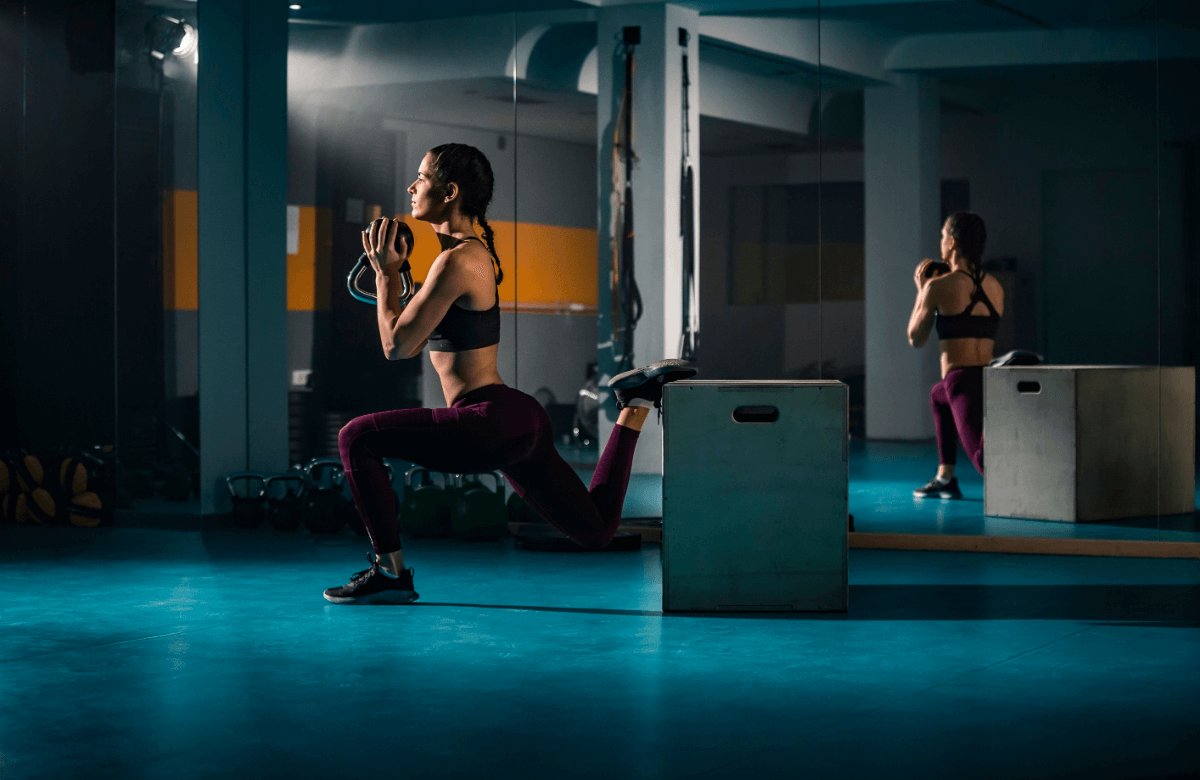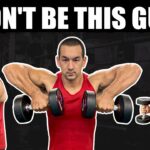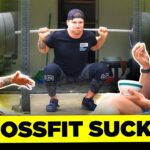Are you tired of the same old squat routine, do you feel the burn in all the wrong places or not see the results you want?
While the squat is a great fundamental exercise that can help you build massive legs, it does have some gaps in terms of muscles worked or isolating muscles.
To fill these gaps, we’ll go over six incredible alternative exercises and four unique squat variations that’ll help challenge your leg muscles in ways you never imagined. Say goodbye to boredom and hello to a leg day that leaves you feeling accomplished and sore in all the right places.
Jump to:
The 6 best squat alternatives
Let’s dive straight into the six alternatives to the traditional squat. These options are the perfect additions to help mix up your leg day routine and target your muscles from different angles.
Lunges
Lunges are one of the most accessible and effective squat alternatives you can add to your leg day routine. They’re a fantastic way to work on balance and stability, and they help to sculpt your lower body.
Here’s how it works:
- Begin standing tall with your feet together and your hands on your hips or at your sides. Keep your chest up and your shoulders relaxed.
- Take a controlled step forward with your right foot. The key here is to make sure your stride is long enough to create a 90-degree angle with your right knee when you lower your body.
- As you step forward, lower your body toward the ground, and bend both knees until your front thigh is parallel to the floor and your rear knee hovers just above the ground.
- Push off the front foot to return to the starting position. You can either alternate legs with each repetition or complete a set on one leg before switching.
Lunges engage your quadriceps and hamstrings and also challenge your glutes, calves, and even your core for stability. To add variety, you can perform forward lunges, reverse lunges, or even walking lunges.
Rep and weight tips:
- Aim for three sets of 15-20 reps per leg.
- You can use body weight for beginners or add dumbbells or a barbell for added resistance as you progress.
Step ups
Another excellent squat alternative to add to your leg day fitness journey are step-ups.
Here’s how you can do it:
- Find a sturdy platform or bench that’s about knee height. This will be your step-up platform.
- Stand in front of the platform with your feet hip-width apart and your chest up.
- Lift your left foot and place it firmly on the platform.
- Push through your left heel and step up onto the platform. As you do this, make sure to keep your chest up and focus on your core stability.
- Once you’re fully standing on the platform, pause for a moment, then step back down with your left foot.
- Repeat the same steps with your left foot, alternating between legs for each repetition.
Step-ups primarily target your quadriceps, glutes, and hamstrings. They also help with your coordination and balance, which means you can better do your daily activities.
Rep and difficulty tips:
- For beginners, start with a lower platform or bench, and as you progress, you can gradually increase the height for added difficulty.
- Aim for three sets of 12-15 reps per leg to really see the most leg gains.
Floor bridge
The floor bridge is another fantastic body compound exercise that uses a different range of motion.
Here’s how to perform a floor bridge:
- Lie on your back with your knees bent and your feet flat on the floor, hip-width apart. Your arms should be by your sides, palms facing down.
- Push through your heels and lift your hips off the ground, creating a straight line from your shoulders to your knees.
- Squeeze your glutes at the top of the movement and hold for a second to maximize the muscle contraction.
- Lower your hips back down to the floor in a controlled manner.
- Repeat this motion for the desired number of repetitions.
The floor bridge works your glutes, which makes it ideal for glute growth, and booty gains. It also uses your hamstrings and lower back muscles, which can add to overall leg and core strength.
Rep and difficulty tips:
- Add three sets of 12-15 repetitions of the floor bridge to your body workout routine.
- As you progress, you can add resistance, such as a weight plate or resistance band around your hips during the exercise.
Deadlift
The deadlift is a powerhouse exercise that deserves a place in any bodybuilding workout routine, and one that can benefit anyone who wants to see some serious leg gains.
Here’s how to perform a deadlift:
- Stand with your feet shoulder-width apart, toes pointing slightly outward. Place a barbell in front of you.
- Bend at your hips and knees to lower your body, keeping your back flat and chest up. Grip the barbell with your hands just outside your knees, using either an overhand or mixed grip.
- Brace your core and lift the barbell by straightening your hips and knees. Keep the barbell close to your body as you stand up.
- Stand tall at the top, fully extending your hips and straightening your back.
- To lower the barbell, hinge at your hips and bend your knees, maintaining a straight back. Lower the barbell to the ground under control.
Deadlifts are a fantastic way to build strength and size in your legs, especially your hamstrings and glutes. They also contribute to overall functional strength and can improve your upper body posture.
Rep and weight tips:
- Start with three sets of 5-8 repetitions and really focus on proper form.
- Start with lighter weights, and gradually increase the weight as you become more confident.
RDL
The Romanian Deadlift, often referred to as RDL, is another excellent exercise to add to your leg day regimen.
Here’s how to execute the Romanian Deadlift:
- Begin by standing with your feet hip-width apart and holding a barbell or dumbbells in front of your thighs, palms facing your body.
- Maintain a slight bend in your knees as you hinge at your hips, pushing your hips backward. Keep your chest up and your back straight throughout the movement.
- Lower the weights slowly along your shins, maintaining a tight core and a straight back. Feel the stretch in your hamstrings as you descend.
- Once you feel a stretch in your hamstrings, reverse the motion by driving your hips forward and standing back up to the starting position.
- Complete your desired number of repetitions, focusing on controlled movement and maintaining proper form.
RDLs are exceptional for isolating the hamstrings and developing hamstring strength as well as definition. They also help with lower back stability and strength.
Rep and weight tips:
- Aim for three sets of 10-12 repetitions with moderate weight to effectively target your hamstrings and promote overall leg development.
- As you progress, you can move onto heavier weights.
Leg curls
Leg curls are a valuable unilateral exercise to add to your leg day routine.
Here’s how to perform leg curls:
- Adjust the machine’s settings to fit your body size, so that the padded lever rests just above your Achilles tendon.
- Then lie face down on the leg curl machine and make sure your legs are fully extended.
- Grasp the handles or the sides of the machine to stabilize your upper body.
- Slowly flex your knees, and lift your feet toward your glutes. Keep your movements controlled and deliberate.
- Once your knees are fully bent, pause for a moment, feeling the contraction in your hamstrings.
- Slowly lower your legs back to the starting position, fully extending them.
Leg curls primarily target your hamstrings and can help you with your unilateral strength.
Rep and weight tips:
- Aim for three sets of 10-12 repetitions to effectively work your hamstrings.
- Start with a manageable weight that lets you maintain proper form and gradually increase the resistance as you progress.
4 Squat variations that target different muscles
Now, let’s explore four squat variations that you can use in combination with the regular squat. These variations will help you build more leg strength.
Bulgarian split squat
The Bulgarian split squat is a challenging variation that focuses on developing single-leg strength and stability.
Here’s how to perform it:
- Stand facing away from a bench or sturdy surface with your feet hip-width apart.
- Place your right foot behind you on the bench and make sure your toes are pointing down. Your left foot should be a few steps in front of you.
- Keeping your chest up and your core engaged, lower your body by bending your left knee. Go as low as your flexibility allows, ideally until your left thigh is parallel to the ground.
- Push through your left heel to return to the starting position.
- Complete a set on one leg before switching to the other.
Bulgarian split squats primarily target your quadriceps, glutes, and hamstrings.
Rep and weight tips:
- Aim for three sets of 10-12 reps per leg.
- Use body weight for beginners, and progress to dumbbells or kettlebells as you become more confident.
Goblet squats
Goblet squats are a fun leg and body exercise that uses your quads, glutes, and core strength.
Here’s how to perform them:
- Hold a dumbbell or kettlebell close to your chest with both hands, keeping your elbows pointed downward.
- Stand with your feet shoulder-width apart.
- Lower your body by bending your knees and hips, keeping your chest up and your back straight.
- Go as low as you comfortably can, ideally until your thighs are parallel to the floor or lower.
- Push through your heels to return to the standing position.
Goblet squats are great for building lower body strength and building a strong core. The weight held close to your chest adds an extra challenge to the exercise.
Rep and weight tips:
- Aim for three sets of 10-12 reps.
- Choose a weight that challenges you but allows you to maintain proper form throughout the movement.
Belt squats
Belt squats offer a unique way to work your lower body without the load on your shoulders and spine.
Here’s how to perform them:
- Start by attaching a weightlifting belt around your waist.
- Find a sturdy platform or two parallel bars and attach a cable or resistance band to the belt.
- Step into the resistance band or attach it to a low pulley machine.
- Position yourself in an upright posture, feet shoulder-width apart.
- Then lower your body into a traditional squat position.
- Make sure to keep your chest up and your back straight throughout the movement.
- Once you reach the desired depth, push through your heels to return to the standing position.
Belt squats primarily target your quadriceps, hamstrings, and glutes, much like an actual squat.
Rep and weight tips:
- Aim for three sets of 10-12 repetitions.
- Gradually increase the weight as you become more comfortable.
Hack squats (Machine)
Hack squats are another fantastic way to workout your lower body.
Here’s how to execute them:
- Begin by positioning yourself on the hack squat machine, with your shoulders against the padded supports and your feet shoulder-width apart on the platform.
- Grip the handles provided on the machine to stabilize your upper body.
- Slowly lower your body by bending your knees and keep your back flat against the padded support.
- Go as low as your flexibility lets you, ideally until your thighs are parallel to the platform.
- Push through your heels to extend your knees and return to the starting position.
Hack squats primarily target your quadriceps, but they also engage your hamstrings and glutes.
Rep and weight tips:
- Aim for three sets of 10-12 reps.
- Adjust the weight on the machine to suit your strength level and gradually increase it as you progress.
FAQ
How to do squats without doing squats?
Try exercises like step-ups, leg curls, Bulgarian split squats, or belt squats. They can effectively target your leg muscles without the need for a standard squat.
What is the best alternative to back squat?
The front squat or hack squat are some of the best alternatives. Front squats use the quadriceps, while hack squats use both the quadriceps and hamstrings.














